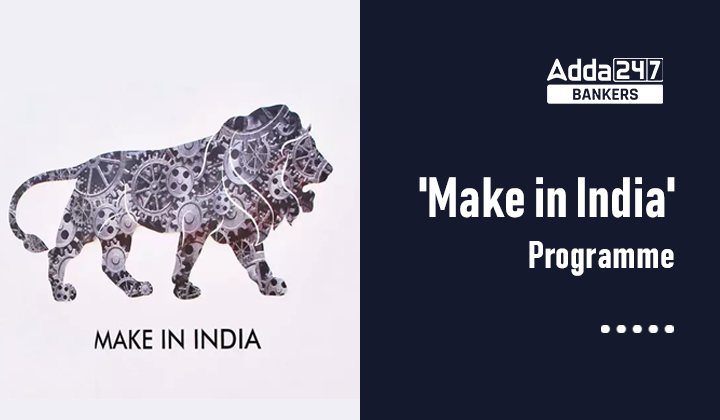Table of Contents
The government’s flagship program ‘Make in India’ completes 8 years: On September 25, 2022, the flagship initiative of the Indian government known as Make in India, completed eight years of ground-breaking reforms. Make in India seeks to promote investment, encourage innovation, improve skill development, and create the best manufacturing infrastructure possible.
Make in India Program
- The Make in India Program, a government effort that was introduced in 25 September 2014, aims to encourage businesses to manufacture in India. This government effort aims to increase foreign investment in the nation while boosting the indigenous industry. Make in India has made significant progress in 27 sectors. These include strategic manufacturing and service sectors.
- The Make in India initiative works to make sure that the business environment in India is favorable for foreign investors conducting business here and contributing to the expansion and development of the country. This has been accomplished through a number of measures that have boosted economic growth and enhanced investor inflows.
- Businesses in India are working to ensure that their products are both “Made in India” and “Made for the World,” adhering to high standards of quality.
- A number of factors indicate a change in Indian manufacturing, including an increase in domestic value addition and local sourcing, as well as a stronger emphasis on R & D, innovation, and sustainability practices.
Main pillars of Make India
- New Processes
- New Infrastructure
- New Mindset
- New Sectors
Initiatives & Achievements made so far
The Indian government has implemented a number of additional initiatives to support Make in India. Flexibility in hiring and retrenchment has been made possible by labor changes. Orders for quality control have been implemented to guarantee quality in regional production. Reduced corporate taxes, public procurement orders, and the Phased Manufacturing Program are other measures to encourage manufacturing and investments.
Foreign Direct Investment (FDI)
The Government of India has implemented liberal policies that make the majority of sectors accessible to FDI via the automatic route to attract international investment. Inflows of foreign direct investment into India totaled US$45.15 billion in the 2014–2015 fiscal year, setting a new high for the past eight years. With $83.6 billion, the year 2021–22 saw the biggest FDI total ever. India is on track to bring in US$ 100 billion in FDI in the current fiscal year as a result of recent economic changes and improvements in the ease of doing business.
Production Linked Incentive (PLI)
A major boost to the Make in India project was provided by the establishment of the Production Linked Incentive (PLI) plan in 2020–21 across 14 important manufacturing industries with an outlay of INR 1.97 Lakh crore. In strategic growth industries where India has a comparative advantage, the PLI Scheme encourages domestic production.
Government’s flagship programme ‘Make in India’ completes 8 years in Hindi
Semiconductors
The Government of India has launched a USD 10 billion incentive program to develop a semiconductor, display, and design ecosystem in India in recognition of the significance of semiconductors in the global economy.
Ease of doing business
Laws are being amended, and guidelines and regulations are being liberalized, in order to remove unnecessary compliance burdens and improve the ease of doing business in India. Through simplification, rationalization, decriminalization, and digitalization, the burdensome compliance with laws and regulations has been decreased, making it simpler to conduct business in India.
Public Procurement (Preference to Make in India) Order 2017
It was issued as an enabling provision to support local industry by giving them preference in public procurement of Goods, Works, and Services. The goal of the strategy is to promote domestic manufacturers’ involvement in public procurement operations over companies that only import goods to trade or assemble them. All Ministries, Departments, Attached, Subordinate Offices, and Autonomous Bodies Controlled by the Government of India are subject to the policy, which also applies to Government Companies as defined by the Companies Act.
National Single Window System (NSWS)
It was soft-launched in 2021 to enhance business efficiency by giving investors access to a single digital platform for approvals and clearances. To improve the investor experience, this site has merged many already-existing clearance processes from different Ministries/Departments of the Government of India and State Governments.
Gatishakti program
It is a government initiative to increase multimodal connections with the nation’s manufacturing hubs. It would guarantee logistical effectiveness in company operations by building out the necessary infrastructure. This will make it possible for people and things to travel more quickly, improving access to markets, hubs, and opportunities while also cutting the cost of logistics.
One-District-One-Product(ODOP) initiative
Another example of the “Make in India” vision, which aims to facilitate the promotion and production of indigenous products from each district of the nation and to give artisans and manufacturers of handloom, handicraft, textile, agricultural, and processed products a global platform. This will help to further the socioeconomic development of the various regions of the nation.
Toy industry
- India’s toy industry has long been dependent on imports. Huge amounts of toys and their parts were imported because of a lack of raw materials, technology, design talent, etc. Toys worth Rs. 2960 crore were imported into our nation in 2018–19. Many of these toys were unsafe, poor quality, fake, and inexpensive.
- The government has made a number of strategic actions to combat the import of unsafe and low-quality toys and to improve domestic toy production. The Basic Customs Duty was raised from 20% to 60%, and other significant measures included the adoption of the Quality Control Order, the requirement to test samples of imported toys, the awarding of more than 850 BIS licenses to domestic toy makers, the creation of toy clusters, etc. A number of marketing campaigns, such as The India Toy Fair 2021, Toycathon 2021, and Toy Business League 2022, were launched to promote indigenous toys and promote innovation and cutting-edge design to meet international standards.
- Despite the Covid-19 pandemic, the Indian toy business has grown significantly in less than two years, largely due to the dedicated efforts of local toy producers. Toy imports fell by 70% in FY21-22. The quality of toys on the domestic market has also improved. The toy export in FY21-22 increased by more than 61% from FY18-19 because of the efforts by industries. Toy exports from India increased dramatically by 636% between April and August 2022 compared to the same time in 2013.
Major Achievements under Make in India
- As per Economic Survey 2021-22, in spite of covid-related disruptions, there is a trend of the positive overall growth of gross value addition (GVA) in the manufacturing sector. The total employment in this sector has increased from 57 million in the year 2017-18 to 62.4 million in the year 2019-20.
- Powered by indigenously produced vaccines, India not only achieved COVID-19 vaccination coverage in record time but also became a major exporter of much-needed life-saving vaccines to many developing and under developed countries across the world.
- Vande Bharat trains, India’s first indigenous Semi High Speed train featuring state-ofthe-art coaches and providing an entirely new travel experience to passengers, is a stellar example of the ‘Make in India’ success story.
- INS Vikrant is India’s first domestically made aircraft carrier. India is achieving new milestones in defence production to reduce imports and be atmanirbhar in this core sector
- Highest ever merchandise exports of 420 billion USD was achieved in FY 2021-22.
- India is currently a mobile and electronics manufacturing hub with global recognition.
Current Affairs
| Current Affairs April 2022 | |




 Daily Current Affairs 18th April 2025, I...
Daily Current Affairs 18th April 2025, I...
 Daily Current Affairs 17th April 2025, I...
Daily Current Affairs 17th April 2025, I...
 Daily Current Affairs 16th April 2025, I...
Daily Current Affairs 16th April 2025, I...





